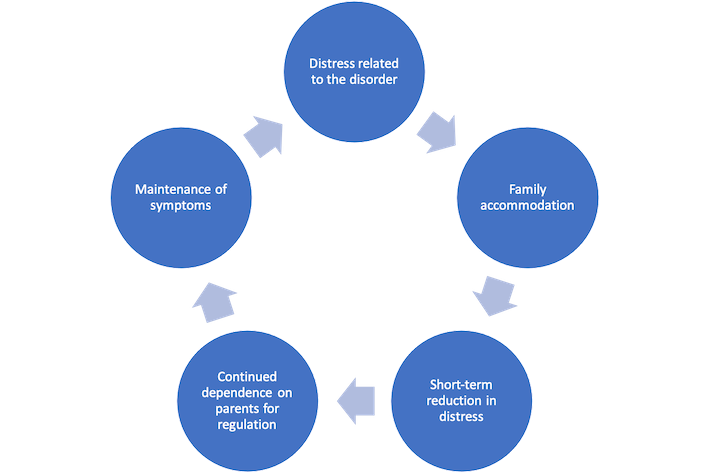What is SPACE for OCD?
At our centre we pride ourselves in having some therapists who did their training as therapists specifically with children and young people. As part of this passion for working within the development of this age range, we did further training in SPACE, which stands for Supportive Parenting for Anxious Childhood Emotions.
What is SPACE?
SPACE is a parent-based (and carer) therapeutic program for children and adolescents experiencing anxiety, OCD and related problems. SPACE is a treatment program used for OCD and some anxiety disorders. The therapist works with the parents to help reduce accommodations and increase support for the young person. SPACE is a manualised treatment program, usually 8-12 sessions. SPACE is useful for when the young person does not want to do therapy, often leaving parents feeling hopeless and helpless. SPACE offers a solution in this situation, to empower the parents with some skills and tools to help their loved one start to reclaim their life from OCD and anxiety. SPACE can also be used alongside the therapist working with the child in individual therapy. So, a session with the parents on SPACE and a session with the child. The child must agree to this, as them feeling safe to share in session is vital. The limits of confidentiality needs to be agreed with the child i.e. what they are happy for the therapist to share with the parents in SPACE sessions.
The components of SPACE
SPACE can be split into two main components:
Increased support
Reduced accommodations
The therapist helps the parents to increase support for their child. This comes in the form of support statements. The formula for this is: Validation + Confidence = Support. For example, “I can see how hard this is for you, and I know you can get through this” or “We know how scared you get when you run low on shower gel, and we are sure you’ll be alright”. Simply put, validate their pain, and put confidence in them. Validation is compassionate. When someone is suffering from OCD or anything, compassion can go a long way to helping them feel understood and seen. The second part of confidence is useful because often people struggling with OCD and who are hooked by their thoughts don’t believe that they can handle it, because it can be so scary, uncomfortable etc. So as parents we can remind them of their resourcefulness and inner strength by telling them that they’ve got this.
Accommodation cycle
The other main component is to reduce accommodations. An accommodation is when a family member does something specifically related to the OCD. Similar to when the sufferer does compulsions, accommodations often have a similar effect at reducing the anxiety, disgust or other emotion that is fuelling the loved one’s OCD. Some example accommodations include: buying excess soap, giving reassurance around the OCD question, keeping your distance from them, putting on their shoes for them, avoiding certain places on the drive home, and hiding things at their request to name a few. There are infinite possible accommodations. We all make accommodations as parents and often these are fine and loving, however when your child is experiencing OCD, accommodations around the OCD are not helpful in the long term. To highlight one example of this, it’s ok if your child is 4 and you are putting their shoes on for them or if there is some other viable reason, however if they are 15 (and know how to put on their shoes) and their OCD is telling them the shoes are contaminated then helping them is not helpful to their long term mental well-being.
In sessions the therapist works with the parents to gradually reduce accommodations, while increased support.
There are other parts to SPACE, however these two components make up the core of the work.
What do SPACE sessions look like?
Your therapist will work with you too:
Understand what is maintaining your child’s OCD
Learn how to increase support
Identify accommodations
Select target accommodations and start to reduce week by week
Formulate and write a supportive letter to your child on the process of reducing accommodations
Plan each week how you will reduce the accommodations
Each week troubleshoot how it went and what accommodation to select next
Strategise how to handle your child’s objections and resistances in a supportive way
Research
There is a randomised control trial comparing SPACE to CBT for anxiety disorders (including OCD). 11% of the children in the SPACE trial had OCD, however some families withdrew before treatment so it is hard to know if that percentage is higher or lower. But either way, it is low and in an ideal world there would be a dedicated trial for OCD. That being said, they found that SPACE is as efficacious as CBT for anxiety disorders.
They have published a case study on SPACE for OCD: https://www.spacetreatment.net/_files/ugd/770d1c_de3d8bc4eebb4a76b81c362692224904.pdf
Conclusion
Parenting can be hard, and when OCD is in the mix to it becomes harder. SPACE aims to offer tools to empower you to help your child reduce their OCD symptoms, while also increasing their feeling of support. I hope this article helps.
SPACE Resources:
SPACE self-book for parents: https://www.amazon.co.uk/Breaking-Free-Child-Anxiety-Scientifically/dp/0190883529/
Website: https://www.spacetreatment.net/ (Find out more, plus resources, and a SPACE therapist directory)
Research: https://www.spacetreatment.net/manual-and-books
SPACE Documentary:
Breaking Free of Anxiety - A Journey Through SPACE

